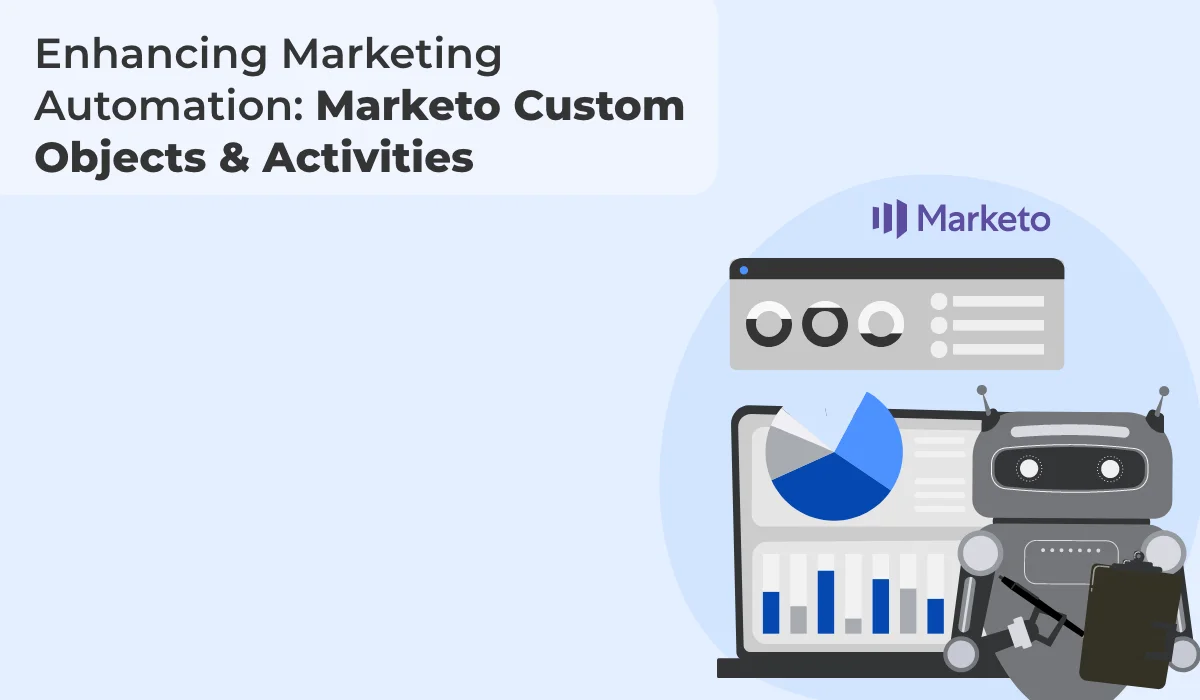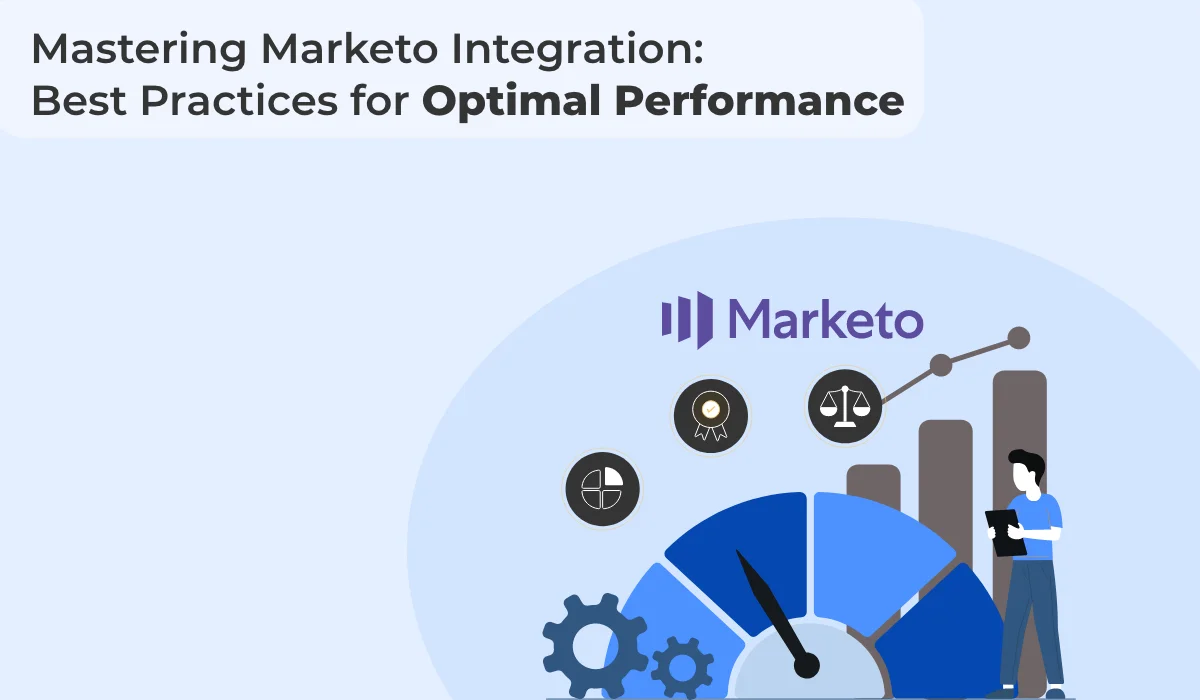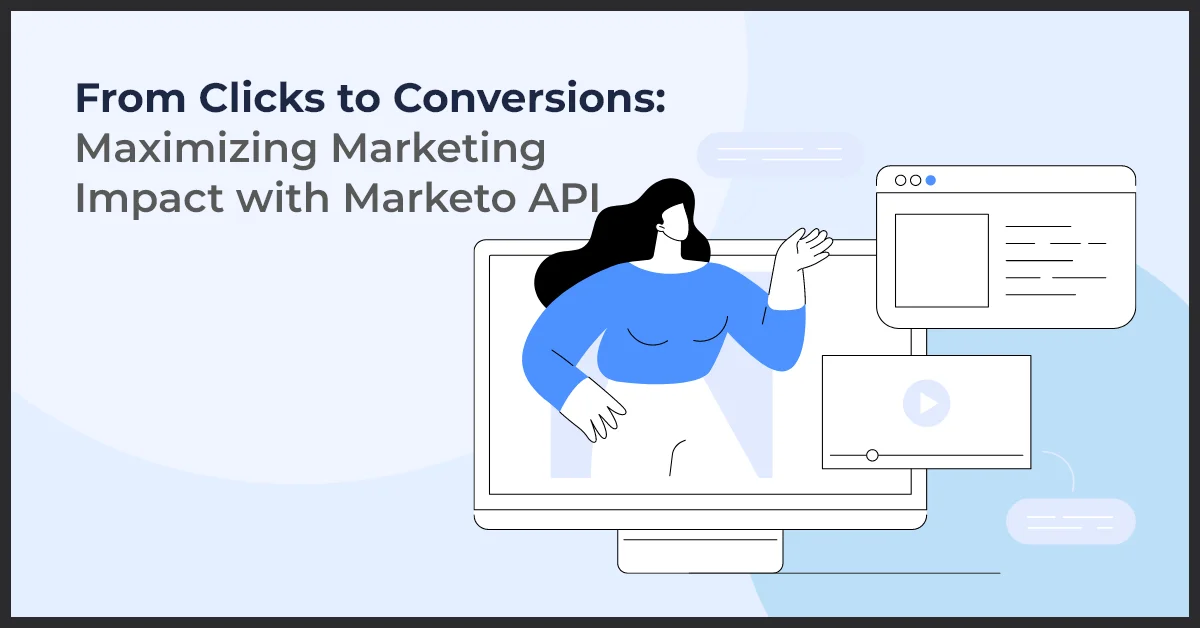Enhancing Marketing Automation: Marketo Custom Objects & Activities

Published on: July 12, 2023
Updated on: July 08, 2024
827 Views
- Marketo
14 min read
Are you ready to witness a marketing revolution? Get ready to unlock the full potential of your campaigns with Marketo's game-changing Custom Objects and Custom Activities.
In a digital landscape where personalized experiences reign supreme, it's time to elevate your marketing strategy to new heights. Envision having the ability to tailor your marketing efforts precisely to your business needs. Marketo's Custom Objects empower you to create unique data structures that align seamlessly with your goals. Say goodbye to generic approaches and embrace the power of customization. It's time to stand out from the competition and make a lasting impression.
But hold on, that's not all! Marketo's Custom Activities take data tracking to a whole new level. No longer will you be limited to basic engagement metrics. With Custom Activities, you can capture valuable insights from custom interactions. Uncover the hidden preferences and behaviors of your audience, gaining a competitive edge like never before.
In this blog, we will delve into the world of Marketo's Custom Objects & Custom Activities and show you how they offer unparalleled flexibility and scalability.
Without further ado, let’s dive in!
A. How Custom Objects Differ from Standard Objects
Understanding the distinction between Custom Objects and Standard Objects is critical when it comes to data management in Marketo. While conventional Marketo objects like leads and contacts provide a solid basis for managing client data, Custom Objects take data organizing and tracking to new heights.
Custom Objects enable enterprises to develop customized data structures that are suited to their requirements. Custom Objects, as opposed to normal objects, let you specify your fields and associations, providing you with total control over your data. This means you may collect and keep bespoke data points relevant to your organization, allowing for more personalization in your marketing initiatives.
B. Use Cases and Benefits of Custom Objects
The benefits of utilizing Marketo Custom Objects extend far beyond mere data customization. Let's explore some use cases and advantages that Custom Objects bring to the table:
1. Advanced Segmentation and Personalization
Segment your audience with custom objects depending on particular criteria and qualities specific to your business. This allows you to produce highly targeted and customized content that engages on a deeper level with your customers. You may increase engagement and conversion rates by using Custom Objects to build dynamic audience groups and adjust your messaging accordingly.
2. Account-Based Marketing (ABM)
Custom Objects are essential in ABM strategies because they allow you to correlate leads with accounts and track account-level activity. Custom Objects may be used to represent accounts and develop relationships between them and the related leads. This gives you a comprehensive picture of your target accounts, allowing for tailored and coordinated marketing activities that promote revenue development.
3. Event Tracking and Management
Custom Objects allow you to effectively collect and manage event-related data whether you're hosting webinars, conferences, or other events. You may use Custom Objects to collect event registrations, attendance information, session choices, and other information. This complete event monitoring tool assists you in measuring event success, analyzing attendee engagement, and optimizing future event strategy.
4. Enhanced Reporting and Analytics
Custom Objects enable you to collect and analyze particular data points relevant to your business goals. You may track and measure metrics that are specific to your reporting needs by setting custom fields inside Custom Objects. This fine-grained level of data analysis enables you to acquire deeper insights into the efficacy of your marketing activities and make data-driven decisions.
Steps to Set Up Marketo Custom Objects
A. Defining Object Fields and Relationships
Setting up Marketo Custom Objects involves defining object fields and establishing relationships between objects. Follow these steps to get started:
- Identify Data Requirements: Determine the specific data points you want to capture within your Custom Object. Consider the unique information that aligns with your marketing goals and supports personalized targeting.
- Create Custom Fields: In Marketo, create custom fields within your Custom Object to capture the desired data. Define field types (text, date, dropdown, etc.) based on the nature of the information you need.
- Establish Relationships: Determine how your Custom Object relates to other objects in Marketo, such as leads or accounts. Create relationships to link these objects and enable data synchronization.
B. Mapping Data and Syncing with CRM Systems
To ensure data consistency and seamless integration with your CRM system, follow these steps:
- Map Fields: Map fields between your Custom Object and corresponding fields in your CRM system. This ensures that data flows accurately between Marketo and your CRM, maintaining data integrity.
- Configure Syncing Rules: Define the syncing rules for your Custom Object to ensure that updates and changes made in either Marketo or your CRM system are properly synchronized.
- Test and Validate: Perform testing to verify that data syncing is working as expected. Confirm that data is accurately transferred between Marketo and your CRM system.
C. Best Practices for Object Design and Management
To maximize the effectiveness of your Custom Objects, consider the following best practices:
- Maintain Consistency: Establish naming conventions and guidelines for object fields to maintain consistency across your Custom Objects. This ensures ease of use, clarity, and effective reporting.
- Plan for Scalability: Anticipate future growth and design your Custom Objects with scalability in mind. Leave room for additional fields and accommodate potential changes to your data structure.
- Document Object Relationships: Document the relationships between your Custom Objects and other objects in Marketo. This aids in understanding data flow, facilitates troubleshooting, and helps new team members familiarize themselves with the system.
D. Managing Marketo Custom Objects
As you start utilizing Marketo Custom Objects, consider the following management practices:
- Regular Maintenance: Regularly review and update your Custom Objects to ensure they align with your evolving business needs. Remove obsolete fields, add new ones, and optimize as necessary.
- Training and Documentation: Provide training to team members on how to work with Custom Objects effectively. Document procedures and best practices to ensure consistent usage across your organization.
- Monitor and Analyze: Keep an eye on the data collected within your Custom Objects and use reporting and analytics features in Marketo to gain insights. Regularly analyze the data to inform decision-making and drive continuous improvement in your marketing efforts.
Integrating Marketo Custom Objects with CRM
A. Syncing Marketo Custom Objects with Salesforce
Integrating Marketo Custom Objects with your CRM system, such as Salesforce, can greatly enhance your marketing and sales efforts. Let's explore the steps to sync Marketo Custom Objects with Salesforce:
- Marketo-Salesforce Integration: Ensure that you have a seamless integration between Marketo and Salesforce established. This integration allows for smooth data flow between the two systems.
- Define Custom Object Mapping: Map the fields between Marketo Custom Objects and their corresponding objects in Salesforce. This mapping ensures that data is accurately transferred between the two platforms.
- Syncing Rules and Schedule: Configure the syncing rules for your Marketo Custom Objects, determining when and how the data is synchronized with Salesforce. Set up a regular syncing schedule to ensure data consistency and timeliness.
B. Leveraging Custom Object Data in CRM Workflows
Once Marketo Custom Objects are synced with your CRM system, you can leverage the valuable data within CRM workflows. Here's how you can make the most of custom object data:
1. Workflow Automation
Utilize the data from Marketo Custom Objects to trigger specific actions or automate workflows within your CRM. For instance, you can set up workflows to notify sales representatives when a custom event occurs or to automate follow-up actions based on specific criteria.
2. Personalization and Segmentation
Leverage the detailed data captured in Marketo Custom Objects to personalize communication with leads and customers. Use this information to create targeted messaging, tailored offers, and customized experiences that resonate with your audience.
3. Enhanced Reporting and Analytics
Tap into the insights derived from Marketo Custom Objects to enrich your CRM reporting and analytics. Gain a deeper understanding of customer behavior, track the effectiveness of personalized campaigns, and measure the impact of your marketing initiatives.
C. Benefits of a Unified Marketing and Sales Data Model
Integrating Marketo Custom Objects with your CRM system offers several benefits through a unified marketing and sales data model:
1. Comprehensive Customer View
By combining data from Marketo Custom Objects with your CRM, you gain a holistic view of your customers. This comprehensive customer profile enables you to understand their preferences, behaviors, and interactions across marketing and sales touchpoints.
2. Enhanced Collaboration
Aligning marketing and sales data within a unified model promotes better collaboration between teams. With a shared understanding of customer insights, both departments can work together more effectively to drive conversions and revenue.
3. Personalized Customer Experiences
Access to detailed data from Marketo Custom Objects empowers you to deliver highly personalized customer experiences. By tailoring your marketing and sales efforts based on individual preferences, you can increase engagement, loyalty, and satisfaction.
4. Improved Decision-Making
The unified data model enables data-driven decision-making across your organization. By analyzing the combined data from Marketo Custom Objects and CRM, you can identify trends, uncover opportunities, and make informed strategic decisions.
Introduction to Marketo Custom Activities
A. Use Cases and Benefits of Custom Activities
Marketo Custom Activities open up a whole new realm of possibilities for tracking and capturing custom interactions within your marketing campaigns. Let's explore some use cases and benefits of Custom Activities:
1. Custom Event Tracking
With Custom Activities, you can track and log specific events or actions that go beyond standard engagement metrics. This could include tracking webinar registrations, content downloads, form submissions, or any other custom events that are important to your marketing strategy.
2. Behavioral Insights
Custom Activities enable you to gain deeper insights into the behavior and preferences of your leads and customers. By tracking custom interactions, you can uncover patterns, identify areas of interest, and better understand the customer journey.
3. Personalized Campaigns
Leveraging Custom Activities allows you to personalize your marketing campaigns based on specific interactions. You can tailor messaging, offers, and content based on the custom activities logged by individual contacts, creating a more targeted and relevant experience.
4. Enhanced Lead Scoring
Custom Activities provide additional data points to incorporate into your lead scoring model. By factoring in custom interactions, you can assign higher scores to leads that exhibit specific behaviors or engagement levels, allowing you to prioritize and focus on the most qualified prospects.
B. Implementing Marketo Custom Activities
- Identify Custom Interactions: Determine the specific custom interactions or events you want to track within your marketing campaigns. These could be actions taken on your website, engagement with specific content, or other unique interactions.
- Create Custom Activity Types: In Marketo, define custom activity types that correspond to the custom interactions you identified. Customize the activity type name, description, and any additional fields required to capture relevant data.
- Mapping Data Fields: Map the data fields within your custom activity types to the corresponding fields in your CRM system. This ensures that the custom activity data is accurately synchronized between Marketo and your CRM.
Configuring Custom Activity Types
A. Mapping Data Fields for Custom Activities
To effectively map data fields for your Marketo Custom Activities, follow these guidelines:
- Define Field Mapping: Determine the fields in your custom activity type that need to be mapped to the corresponding fields in your CRM. This ensures data consistency and proper synchronization.
- Consider Data Integrity: Ensure that the data types and formats in your custom activity fields align with the corresponding fields in your CRM. This avoids data conflicts or inconsistencies during syncing.
B. Tracking and Logging Custom Activities in Marketo
To track and log custom activities in Marketo, consider the following steps:
- Set Up Activity Tracking: Configure the necessary settings in Marketo to start tracking and logging custom activities. This includes enabling activity logging, defining trigger conditions, and specifying the data to capture.
- Implement Tracking Mechanisms: Implement the necessary mechanisms, such as JavaScript or API calls, to capture and log custom activities on your website or within your campaigns.
Reporting and Analytics for Custom Activities
Advanced Segmentation and Personalization using Custom Activities
One of the significant advantages of Marketo's Custom Activities is the ability to leverage them for advanced segmentation and personalized marketing. Here's how you can utilize Custom Activities for enhanced segmentation and personalization:
1. Activity-Based Segmentation
By analyzing the specific Custom Activities logged by your leads and customers, you can segment your audience based on their unique interactions. For example, you can create segments of users who have attended a specific webinar, downloaded a particular whitepaper, or interacted with a specific feature of your product. This enables you to tailor your messaging and offers to each segment's specific interests and needs.
2. Personalized Messaging and Content
With the insights gained from Custom Activities, you can craft highly personalized messaging and deliver targeted content to your audience. For instance, if a lead has engaged with a specific Custom Activity related to a particular product or service, you can send them personalized emails or recommendations based on that interaction. This level of personalization increases engagement and drives better results.
3. Behavioral Triggered Campaigns
Custom Activities can trigger automated campaigns based on specific interactions. For example, if a lead visits a certain page on your website or interacts with a particular piece of content, you can set up automated workflows to send them relevant follow-up emails or nurture them with targeted content based on their demonstrated interests.
By leveraging Custom Activities for advanced segmentation and personalization, you can create highly targeted marketing campaigns that resonate with your audience and drive better engagement and conversion rates.
Syncing Custom Activities with CRM Systems
Leveraging Custom Activities for Sales Enablement
Integrating Custom Activities with your CRM system unlocks valuable opportunities for sales enablement. Here's how you can leverage Custom Activities to empower your sales teams:
1. Real-Time Activity Insights
By syncing Custom Activities with your CRM, you can provide your sales team with real-time insights into the activities and interactions of leads and customers. This enables them to have more informed and meaningful conversations, tailor their approach, and follow up based on the specific engagement exhibited by each prospect.
2. Prioritizing Sales Efforts
With Custom Activities integrated into your CRM workflows, sales reps can prioritize their efforts based on the most relevant and impactful activities performed by leads. They can focus on leads who have exhibited specific behaviors or interactions that indicate a higher level of engagement or readiness to purchase.
3. Sales and Marketing Alignment
Custom Activities bridge the gap between sales and marketing by providing sales teams with visibility into the marketing interactions of prospects. This shared understanding helps align sales and marketing efforts, ensuring a cohesive and consistent customer experience throughout the sales cycle.
Advanced Reporting and Analytics with Custom Objects & Custom Activities
Utilizing Custom Objects & Custom Activities in Engagement Programs
The combination of Custom Objects and Custom Activities opens up opportunities for advanced reporting and analytics within Marketo. Here's how you can utilize these features in engagement programs:
1. Comprehensive Engagement Tracking
By incorporating Custom Activities into your engagement programs, you can track and measure the effectiveness of specific interactions and touchpoints across the customer journey. This helps you gain a deeper understanding of engagement levels and optimize your programs for better results.
2. Conversion Analysis
Custom Objects and Custom Activities provide a wealth of data points to analyze conversion rates and identify opportunities for improvement. By analyzing the data associated with Custom Objects and Custom Activities, you can pinpoint areas where conversions are dropping off or identify the most effective actions that lead to conversions.
3. Iterative Optimization
By utilizing Custom Objects and Custom Activities in engagement programs, you can continuously iterate and optimize your campaigns. Analyze the data to uncover patterns, identify successful strategies, and make data-driven decisions to improve the overall performance of your programs.
Conclusion
The integration of Marketo Custom Objects & Custom Activities opens a world of possibilities for marketers seeking to elevate their campaigns. By leveraging these customizable features, businesses can unlock personalized experiences, gain deeper insights, and drive impactful marketing initiatives. Seamlessly integrating with emerging technologies like AI and IoT, Marketo Custom Objects & Custom Activities empower marketers to deliver hyper-targeted messaging and leverage data-driven strategies for maximum ROI.
Ready to revolutionize your marketing automation? Contact Growth Natives today at info@growthnatives.com or call +1 855-693-4769. Our team of experts is dedicated to helping you harness the full potential of Marketo Custom Objects & Custom Activities and take your marketing to new heights. Don't miss out on this opportunity to transform your campaigns and achieve unparalleled success. Reach out to us now and let's embark on a journey of marketing excellence together!
Frequently Asked Questions
Marketo Custom Objects are user-defined data objects that allow you to store and manage additional information beyond the standard lead, contact, and account records. They enable you to tailor Marketo to your specific business needs and track unique data points relevant to your marketing initiatives.
Marketo Activities are records of interactions and engagements tracked within the Marketo system, such as email opens, clicks, form submissions, webinar attendance, website visits, and other engagement events. They provide valuable insights into lead behavior and engagement patterns.
Marketo custom objects are created and managed through the Marketo admin interface or the Marketo API, where administrators can define custom fields, relationships, and permissions, import and export data, and configure object-specific settings.
Benefits of using Marketo custom objects include improved data management and organization, enhanced segmentation and targeting capabilities, personalized communication, streamlined workflows, deeper insights into customer interactions, and the ability to track custom metrics and KPIs.
Custom objects in Marketo are records that hold additional data related to leads or accounts, while custom activities track specific interactions or events associated with leads, such as webinar attendance or content downloads. Custom objects store structured data, while custom activities capture specific actions or engagements.
Marketo Custom Objects can store various types of data, including but not limited to product information, event registrations, webinar attendance, subscription preferences, customer feedback, purchase history, and any other custom attributes relevant to your marketing efforts.



